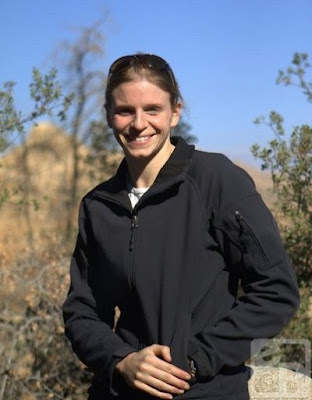 |
| Trail Lite (left) and Air Core + cat (for scaling) |
Does the Job - Therm-A-Rest Women's Trail Lite
I've had this pad for years; it was my first real backpacking sleeping pad. It's been used on everything from climbing trips to my living room floor for house guests. Unlike the Air Core, the Trail Lite is a women's specific pad. According to industry experts, women's specific pads are made with more insulation in the torso and foot area because that's where women get coldest. Though, having more insulation around your core seems like a good idea regardless of gender. I do still feel like I get cold sleeping on this pad, and feel like most of the heat I lose is through my hips.
 |
| The Trail Lite rolled up after a long, wet night! |
As far as inflation is concerned, the pad is supposed to be self-inflating and for the most part, it is. Over the years, it's worn out a bit and seems to take longer to inflate.
The Trail Lite retails for $64.95 on Backcountry.com. The pad comes with a stuff sack, but no patch kit.
Pwns the Job - Big Agnes Insulated Air Core Pad
This pad came to me thanks to a contest through Moosejaw on twitter. I've taken it out this spring in temperatures close to freezing and given to visiting friends to sleep on. The specs state that it's a three season pad with PrimaLoft insulation and should be comfortable down to 15ºF. I stayed warm on it in 35º-40º temperatures; I didn't feel heat loss through specific areas of my body. I could definitely have used a warmer sleeping bag that night, though!
 |
| All inflated and ready for a night in the woods! |
The only real negative I've found is the inflation valve. It took me a few tries to get the valve completely open; it has two independently operating pieces to make sure it stays closed when inflated. It took a few minutes to inflate, and I found myself a little dizzy after 20 big breaths! But once it was inflated, it was a dream to sleep on.
The regular length Insulated Air Core retails for $69.95 on Backcountry.com and $79.95 on REI.com
The Bottom Line
There are a bunch of different sleeping pads out there all with different features. But as someone who gets cold easily, is taller than the average girl, and likes to save space, I've definitely got a favorite between these two. The Big Agnes Air Core Insulated Pad will be coming with me on my next trip for sure!
As a note, if you have an inflatable sleeping pad, take care to make sure you don't puncture it. Leaks can be a pain. Always carry a patch kit, and I always store the pad in the stuff sack to keep it safe. It's also important to store self-inflating pads with the valve open. This prevents the materials from compressing over time.
Do you have a sleeping pad you recommend? Do you have experience with either of these pads? Tell me in the comments!


























